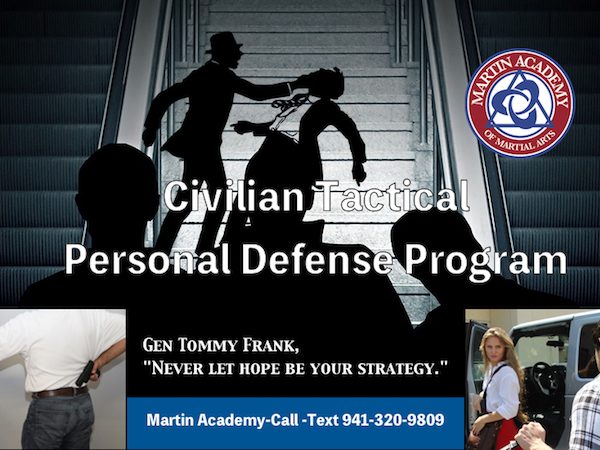PERSONAL DEFENSE PROGRAM

Civilian Tactical / Personal Defense Program
We’re glad you’re here and hope that we can assist you to first learn to become more aware of what’s going on around you. To keep an open mind and decide to take an active roll in learning to pick up on non verbal clues in people, in your environment, in behavior ( yours and others), and a few tools to help you should the need for physical persuasion arise.
Our objective is to familiarize you with the basic principles of Personal Safety & Defense and to get you thinking on what you can do for yourself and those will you. It will take more than a few hours of training to put various responses, thought patterns, physical and mental training into muscle memory, but that will help you learn to respond ( not react) in seconds should the need arise. But this is a beginning.
Most people don’t think twice about preparing or getting insurance for a car, or a house. Many spend more time prepping to find a college to attend, or plan a wedding but very few take the time or make the effort to prepare for a violent encounter. It’s ugly, no one likes to think about it and feels the likelihood of it happening to them is low. Which is all true but do you want to be the one who happens to be selected and not be ready?
What is Personal Safety and is it different from Self Defense? In my mind, yes.
Personal Safety, to me, is doing in advance what you need to do by training your mind as well as physically preparing BEFORE something happens. Self Defense is when you have already been selected for a violent encounter, you are already behind because the threat is one step ahead of you by initiating the attack. You are in the midst of trying to save yourself with the attack in progress because you haven’t prepared beforehand. Military prepares before something happens as we all should just on a different level, you call the police AFTER something happens, to report it. Police don’t come until after something happens.
For personal safety, the mind has to be trained to help you. The best defender has prepared themselves both physically and mentally. You can know all the physical techniques in the world but if you can’t bring yourself to execute them, or create safe awareness habits then your training is incomplete. You need to decide now what you will and won’t do. Through your training, this will be revealed and assist you on a direction to take.
Be prepared to have a few laughs; however, we ask that you bring a serious mind-set and embrace your training with intensity and enthusiasm. Take this training opportunity to heart, as if your life depended on it, because at some point, it may.
William April, who I took a class from and was the New Orleans prison psychiatrist, – says a predator making a decision to select or deselect takes seconds.
One study claims that it takes a predator / threat about seven seconds to assess you as prey. And the actual attack will happen very quickly and in many cases be very brutal.
Three Steps to start now are:
Mental Preparedness + Mental Conditioning = Mental Awareness
-Mental Preparedness is a commitment to your personal security to not put your head in the sand and accept the fact that we live in an increasingly violent world. Do an attitude check and make sure your attitude is one that will help you go home at night.
-Mental Conditioning helps you develop awareness skills and keep them sharp.
Marcus Wynn – has drills like: What do I see right now? What am I hearing right now? What am I feeling right now? Make learning good awareness habits a game until it comes natural. We can help with that process.
-Mental Awareness is a state of alertness that takes the element of surprise away from the threat. Being conscious of your immediate environment, many people(men and women) tell me that are aware. But from my experience of watching them – they are clueless. Immediate environment is 21 to 30’/360 degrees. This is your ideal safety zone whether on foot, in a car or seated in a public place. 21 to 30’ is for creation time and other is “critical distance”.
How we sit, how we stand, where we sit, how we use our hearing, our reflections, noticing things that are out of place or don’t belong there are all Situational Awareness. That should be in place whether we are in our neighborhood, shopping or in our car.
These are tools that can help you escape and avoid a violent confrontation. But you must develop them and constantly sharpen those tools.
There is one important psychological factor to remember regarding self defense. You are strengthening yourself and becoming more prepared. Don’t deny yourself an opportunity to improve your well-being simply because of your own or someone else’s perception on age, because that’s exactly how an attacker wants you to think. No matter what our age, in some way we are vulnerable.We must learn to deal with it and do our best to protect ourselves.
We are responsible for our own safety, we cannot hope someone else will be there or help us. Sadly even if they are there does not mean they will help us, that I know from first hand.
Contact Us
To expedite your request, please click the button below to tell us a little about your inquiry:
